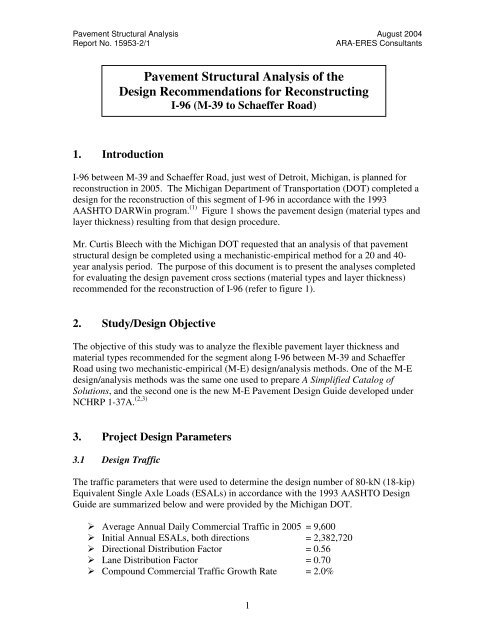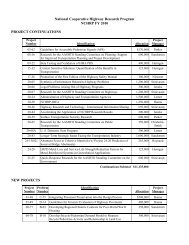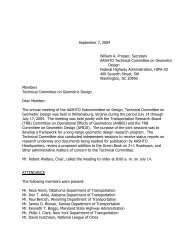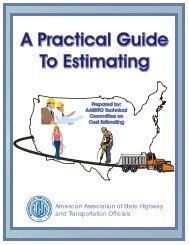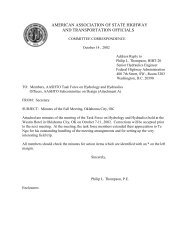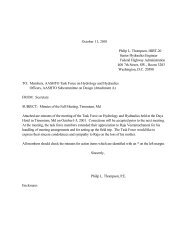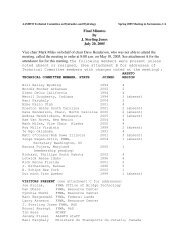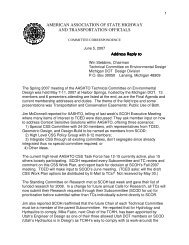Pavement Structural Analysis of the Design Recommendations for ...
Pavement Structural Analysis of the Design Recommendations for ...
Pavement Structural Analysis of the Design Recommendations for ...
Create successful ePaper yourself
Turn your PDF publications into a flip-book with our unique Google optimized e-Paper software.
<strong>Pavement</strong> <strong>Structural</strong> <strong>Analysis</strong> August 2004<br />
Report No. 15953-2/1 ARA-ERES Consultants<br />
1. Introduction<br />
I-96 between M-39 and Schaeffer Road, just west <strong>of</strong> Detroit, Michigan, is planned <strong>for</strong><br />
reconstruction in 2005. The Michigan Department <strong>of</strong> Transportation (DOT) completed a<br />
design <strong>for</strong> <strong>the</strong> reconstruction <strong>of</strong> this segment <strong>of</strong> I-96 in accordance with <strong>the</strong> 1993<br />
AASHTO DARWin program. (1) Figure 1 shows <strong>the</strong> pavement design (material types and<br />
layer thickness) resulting from that design procedure.<br />
Mr. Curtis Bleech with <strong>the</strong> Michigan DOT requested that an analysis <strong>of</strong> that pavement<br />
structural design be completed using a mechanistic-empirical method <strong>for</strong> a 20 and 40year<br />
analysis period. The purpose <strong>of</strong> this document is to present <strong>the</strong> analyses completed<br />
<strong>for</strong> evaluating <strong>the</strong> design pavement cross sections (material types and layer thickness)<br />
recommended <strong>for</strong> <strong>the</strong> reconstruction <strong>of</strong> I-96 (refer to figure 1).<br />
2. Study/<strong>Design</strong> Objective<br />
The objective <strong>of</strong> this study was to analyze <strong>the</strong> flexible pavement layer thickness and<br />
material types recommended <strong>for</strong> <strong>the</strong> segment along I-96 between M-39 and Schaeffer<br />
Road using two mechanistic-empirical (M-E) design/analysis methods. One <strong>of</strong> <strong>the</strong> M-E<br />
design/analysis methods was <strong>the</strong> same one used to prepare A Simplified Catalog <strong>of</strong><br />
Solutions, and <strong>the</strong> second one is <strong>the</strong> new M-E <strong>Pavement</strong> <strong>Design</strong> Guide developed under<br />
NCHRP 1-37A. (2,3)<br />
3. Project <strong>Design</strong> Parameters<br />
3.1 <strong>Design</strong> Traffic<br />
<strong>Pavement</strong> <strong>Structural</strong> <strong>Analysis</strong> <strong>of</strong> <strong>the</strong><br />
<strong>Design</strong> <strong>Recommendations</strong> <strong>for</strong> Reconstructing<br />
I-96 (M-39 to Schaeffer Road)<br />
The traffic parameters that were used to determine <strong>the</strong> design number <strong>of</strong> 80-kN (18-kip)<br />
Equivalent Single Axle Loads (ESALs) in accordance with <strong>the</strong> 1993 AASHTO <strong>Design</strong><br />
Guide are summarized below and were provided by <strong>the</strong> Michigan DOT.<br />
Average Annual Daily Commercial Traffic in 2005 = 9,600<br />
Initial Annual ESALs, both directions = 2,382,720<br />
Directional Distribution Factor = 0.56<br />
Lane Distribution Factor = 0.70<br />
Compound Commercial Traffic Growth Rate = 2.0%<br />
1


